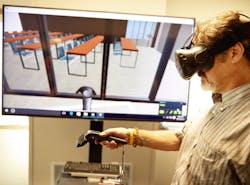*Article contains affiliate links that BUILDINGS feels are relevant to our readers. We receive a fee if any items are purchased using these links.
If you’re looking for an innovative way to streamline your next building project, consider virtual or augmented reality, two of the latest technologies architects and construction companies are using to gain the upper-hand on competitors while attracting new customers.
Virtual reality (VR), along with augmented reality (AR), mixed reality and 360-degree cameras are slowly transcending the buildings market as they allow users to digitally experience a space before transforming it—saving everyone both time and money.
While all of the mentioned technologies are similar, they do have distinct differences.
What is Virtual Reality?
Virtual reality works by transporting the user into a digital world that is experienced and interacted with through sensory devices, such as the Oculus Rift headsets.
Oculus Inc.’s Brian Kern points out how VR technologies, such as Building Information Model (BIM) software, give architects a much better understanding of projects and designs, which in turn helps them to deliver better outcomes, along with improved communication and client collaboration.
The main difference between the 360-degree devices vs. VR and AR devices is that 360 offers real footage while VR and AR video are simulated and allow the viewer to interact with the scene he or she is viewing.
“Virtual reality renderings or computer-generated simulations of an environment not only help streamline the design process, but can also be used in unique ways by clients during all phases of a project,” he notes. “In addition to speeding up the design process, virtual reality renderings serve as a digital data model for a project’s characteristics, including 3D geometry, 4D sequential data relative to time and phasing, and cost data.”
[Emerging technology: Indoor Location Services]
Virtual Reality vs. Augmented Reality
Augmented reality can also provide similar time—and cost-saving results. It blends the user’s real-world environment with virtual renderings into your screen view. The HVAC industry is one specific sector embracing both VR and AR—the infographic below explains their differences.
Click on the image to view the entire document:
“AR can analyze layouts and designs, and even predict problems before any work begins, allowing issues to be correct before ground breaks,” says Jordan Moffett, a virtual design and construction manager at McCarthy Building Companies, Inc. “During a renovation, it can be hard for people to envision new cabinets, walls or even paint colors. With augmented reality, contractors can highlight new features within a real space, allowing the vision to come to life in real time. AR can also catch any issues before any construction begins and as construction progresses.”
Smart reality is one app that building owners, facility managers and construction companies are using on their projects. The free app allows users to walk around BIM models with augmented reality and further inspect details in 3D with virtual reality.
360-Degree Devices: Another Full-Range View
360-degree devices are popular tool that also show the camera user’s real-life surroundings. C|net editors Joshua Goldman and John Falcone note that “for most of us, 360-degree spherical content will be the first immersive ‘VR’ experience we have.”
The main difference between the 360-degree devices vs. VR and AR devices is that 360 offers real footage while VR and AR video are simulated and allow the viewer to interact with the scene he or she is viewing.
BUILDINGS editor-in-chief Janelle Penny is a content producer who incorporates 360 videos to engage her audience digitally. The 360-degree video of her office’s active shooter drill provides an eye-opening, immersive experience for viewers.
Christoph Trappe, chief content officer for Stamats—our corporate parent company—also uses 360 videos. Here’s a video of his recent visit at the Chicago headquarters for TURF, an acoustic design company, which gives a full 360-degree view of his tour throughout the space.
Simple and affordable, 360 videos offer options to share with audience’s the user’s entire surroundings in real time. The camera used for the videos featured here, an Insta 360 Nano, costs under $100 and requires only an app to operate, making it consumer-friendly.
You can find a wide variety of cameras on Amazon to suit your project and budget:
- Vuze XR Dual VR Camera
- Samsung Gear
- Ricoh Theta 360 Camera
Digital Data for Professional Purposes
If you are considering implementing virtual or augmented reality, along with 360-degree views, for your next building project, Kern recommends collecting and saving all digital data related to the project.
“One way to repurpose virtual reality renderings post-design process is to implement them into the overall marketing strategy of the project,” he suggests. “This is a great tactic for building owners to attract and retain tenants as printed materials with images of 3D renderings can be used to keep current tenants updated on the construction process while also attracting potential new tenants.”
From the early stages of construction to maintaining the building once it’s complete, it’s clear that the new technologies are allowing users to fully see what they’re looking at from every angle. VR, AR and other related technologies can provide a digital advantage where traditional media couldn’t before—assurance for customers on their investments, making final results less surprising and more satisfying for all.
Two handpicked articles to read next:
About the Author

Adrian Schley
Staff Writer
Adrian Schley has been writing for interiors+sources magazine since March of 2018 and creates content for the BUILDINGS team. She earned her BA in journalism at the University of Iowa, where she also studied English.
